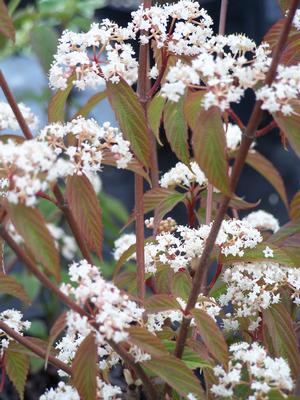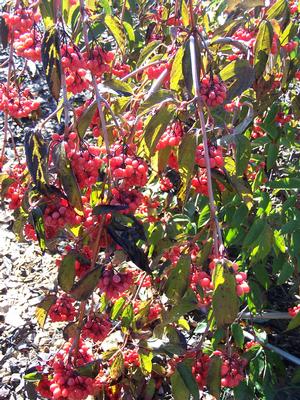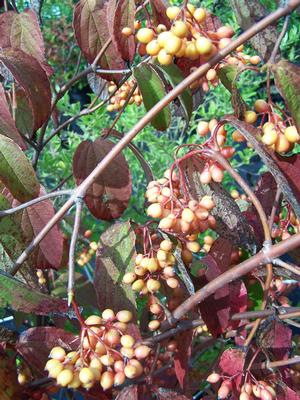
Viburnum setigerum in bloom

Tea Viburnum's typical fruit set

another fruiting detail when berries are golden before deepening in color with the added bonus of good fall leaf color
Viburnum setigerum: The Tea Viburnum
Viburnum setigerum is the Tea Viburnum from central and western China. First described in the Journal of Botany in 1882 eventually it was introduced in 1901 by Ernest Wilson, probably Arnold Arboretum's most traveled plant explorer. The Tea Viburnum is a moderately large shrub growing taller than wide eventually from 8 to 10 feet high with a somewhat narrower spread between 6 and 8 feet.
Flowers are white cymes which are divided into 5 segments. The overall look of each inflorescence composed of multitudes of small milk white florets is a solid flattened dome. By the standards of other viburnums they are relatively small, about one to two inches in diameter. But for their smaller size they compensate in numbers. Adorning the shrub at tips of branches in May they display handsomely and only increase the effect when shrubs are planted in a group of three or more as part of a grander landscape plan.
Viburnum setigerum is commonly called Tea Viburnum because the the monks situated upon Mount Omei processed and steeped the leaves making a sweet tea. Its long, serrated leaves tend to drape attractively. Each leaf may meausure as much as six inches in length with a diameter of one and one-quarter inches up to twice that width. They often emerge with a red-bronze flush and settle back to medium green to bluish green. However, foliage often holds onto the bronzing for some time. And all new leaves which may emerge after the initial flush will demonstrate this color mix well into summer. Tea Viburnum's autumn color varies with each new fall bringing with it different hues. We've had years where the foliage turned vibrant red, red-orange and sometimes with a golden hue in the mix. On occasion the autumn color is a handsome red-purple. But one year the leaves actually turned so dark purple that from afar the overall color appeared to be black, an unexpected and stunning surprise – with the copious scarlet-orange fruit it smacked of Halloween quintessence!
This is one viburnum that is actually hermaphroditic with both male and female flowers on a single shrub allowing for self-pollination. The trait of being self-fruitful is unusual in the world of viburnums. Nearly all viburnums though they carry flowers of both sexes on a single plant require another closely related individual so that cross-pollination may occur and. When cross-pollinated berries develop. But with Viburnum setigerum an individual shrub can self-pollinate for a spectacular annual fruit set. And what a fruit set it is! The fruit set is consistent, opulent and so heavy that in especially good berrying years the stems weep under the weight. The glorious fruit is memorable. Many who happen upon it for the first time “ooh” and “aah” at its opulence.
There is only one selected form of which we are aware and that is 'Auriantiacum'. It is a golden to orange-gold berrying form that, though it can be found in the trade, is less common than the straight species. We wouldn't say it's better than the straight species, only different in the color of the fruit. But, of course, aesthetic preferences are as subjective as is the appreciation of humor or jazz.
The lower quarter to third of the shrub may display bare stems. Some may consider this a character flaw. If visually problematic this feature is easily remedied by setting perennials or shorter shrubs near its base which will mask naked stems.
The growing range for Tea Viburnum is narrower than for many others of its cousins. But it is perfectly hardy for us in northeastern Connecticut with a USDA cold climate hardiness zone rating of between 5 and 7, -20F to 0, possibly just spilling over into cooler portions of zone 8. Our friend, Betsy Kaemmerlen, purchased one and interred it upon returning home in USDA zone 8 South Carolina. We await her assessment. But where Tea Viburnum is a sure bet culture is easy; plant in fertile, moisture-retentive soils in sited full to mostly sunny conditions and you're good to go.
With such easy-going character, pretty flowers, handsome summer affect and exceptional fall interest might you not consider Viburnum setigerum, the Tea Viburnum as a candidate for your gardens? Set by itself, in a shrubby hedgerow or planted in multiples as part of a larger scheme or even as a backdrop to a perennial border it is worthy, handsome and easy. We would not be without it. Dig in. Have fun.
penned by Wayne Paquette, October 8, 2014